Isis in Ireland ©

The Genesis of Isis went everywhere.
The Temple of Isis spread enlightenment to the whole world in a Golden Age before the dawn of monotheism.
According to the Pagan foundation legend, Assur was the inventor of agriculture. He established the first hereditary kingdom on earth (in the Nile Delta?). After he had raised his own people up from savagery and ignorance, he went about teaching the arts of civilization to the whole world. Upon returning home from one of his missionary tours abroad, a company of evil conspirators murdered Assur. Isis resurrected Assur from the dead. The Pagan religion and the bloodline of 'divine kings' were born from the union of Isis and her resurrected king, Assur.
The Pagan foundation legend was orally passed down through generations. It was told as the adventures of a single individual in a single lifetime. However, thousands of years of pre-history were compressed into the story of Assur.
The Assur who invented agriculture and founded the first kingdom was a much earlier incarnation of Assur than was the Assur who carried the arts of civilization to the whole world. The original Assur fathered an ancient empire of related UrRean kingdoms shortly after the melt down of the Ice Age. That prehistoric empire fell into economic disarray, political disorder, and internal warfare. When Isis resurrected Assur from the dead, she rebuilt his ancient empire.
(See the Sunwing page on this web site for a description of who and what were the UrRean kingdoms.)
Assur's legendary travels carrying the arts of civilization to the world occurred AFTER Isis resurrected him from the dead. That is to say, those travels of Assur were minions of Isis carrying the arts of civilization to the rest of the world. Agriculture was one of the civilized arts that Paganism taught the world. The arrival of the Temple of Isis in Ireland was coincident with the beginnings of agriculture there.
Minions of Isis carried the Genesis of Isis to Ireland a thousand years before Abraham ventured down into Egypt, and two thousand years before the Celts arrived in Ireland. For many centuries, people believed that Saint Patrick drove the snakes out of Ireland. Zoologists now know that there never were any snakes native to Ireland. Isis was the serpent goddess. Saint Patrick drove the Temple of Isis out of Ireland.
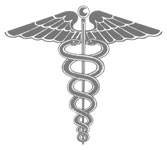
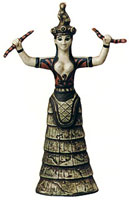
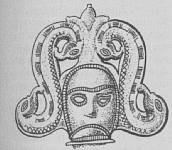
Isis was "twice wise." She was the goddess of "double wisdom." The Sacred Asp of Isis was her symbol of double wisdom. In Pagan art from all over the world, two serpents are frequently depicted to symbolize Isis and double wisdom. An artifact depicting an Irish twin-serpent goddess has been found that clearly relates her to Isis and other twin-serpent goddesses. The exact identity of that twin-serpent goddess in the Irish pantheon is uncertain.
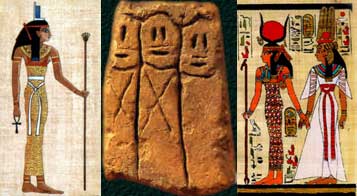
Perhaps the twin-serpent goddess was Brigid. She was the most powerful goddess in the Celtic pantheon. Brigid was known by many names. One of her names was Bride. Her name Bride identifies her as a "Daughter of Isis." Daughters of Isis who went out as gift wives and temple virgins carried the Genesis of Isis to many lands. Some of those Daughters of Isis became the mother goddesses of their adopted lands.
(See the Alphabet V page of this website for a discussion of the "Daughters of Isis" goddesses.)
Brigid was a Celtic "Triple Goddess." She was a maiden (virgin), mother, and crone.
(See the Alphabet V, M, and W pages of this website for a discussion of Isis as maiden, mother, and crone.)
Those Daughters of Isis who became the mother goddesses of various tribes and nations were frequently depicted wearing a 'genetic crossing' sash that identified them with the EarthMother Goddess, Isis. No Irish images of Brigid(Bride) wearing a genetic crossing sash have been found. However, an etched in clay version of a Celtic triple mother goddess like Brigid, who is depicted wearing the genetic crossing sash, has been found in Burgundy, France.
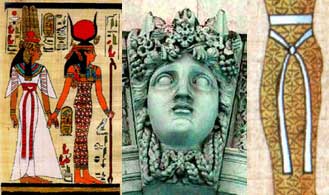
Next to Saint Patrick, Brigid was probably the most powerful religious figure in all of Irish history. So fiercely did the Irish cling to their goddess that eventually she was canonized as a Christian saint, Saint Brigit. Nearly all imagery of Pagan Ireland has disappeared due to the combined effects of the Irish climate and Christian suppression. Pagan Ireland lives on in folklore tales and legends, but Pagan images that could be destroyed have been destroyed. Nearly all images of Brigid are relatively modern ones. However, some Pagan symbolism may have unwittingly found its way into the modernized images of the goddess. The knotted braids of this relatively modern figure of Brigid may be reminiscent of the 'genetic crossing' sash in earlier images.
(See the Isis in Central America page of this website for a further discussion of the 'genetic crossing' sash.)
Ireland and the British Isles abound with Pagan monuments that pre-date the Celts.
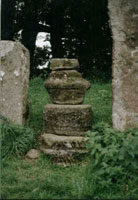
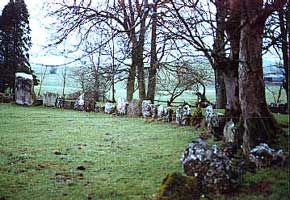 Ancient Pagan tribes of Ireland commonly believed that their deities resided in nature and were best worshipped on special days at certain 'holy' sites marked by megalithic rocks and sacred groves. Their history and 'literature' consisted of oral traditions and heroic legends that were recited from memory and sometimes sung as ballads. Although there are a few runic inscriptions left from the Celtic period of Ireland, there are no written records or works of graphic art left over from the pre-Celtic peoples of Ireland.
Ancient Pagan tribes of Ireland commonly believed that their deities resided in nature and were best worshipped on special days at certain 'holy' sites marked by megalithic rocks and sacred groves. Their history and 'literature' consisted of oral traditions and heroic legends that were recited from memory and sometimes sung as ballads. Although there are a few runic inscriptions left from the Celtic period of Ireland, there are no written records or works of graphic art left over from the pre-Celtic peoples of Ireland.
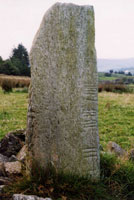 In addition to world-renowned New grange, pillar stone monoliths, stone circles, circle stone "granges," and dolmen burial sites mark the Irish countryside. The pillar stones may have been boundry markers; they may have marked rallying places for tribal gatherings, or they may have been the seats of government for tribal or inter-tribal council circles. The pillar stones probably served political purposes of some kind.
In addition to world-renowned New grange, pillar stone monoliths, stone circles, circle stone "granges," and dolmen burial sites mark the Irish countryside. The pillar stones may have been boundry markers; they may have marked rallying places for tribal gatherings, or they may have been the seats of government for tribal or inter-tribal council circles. The pillar stones probably served political purposes of some kind.
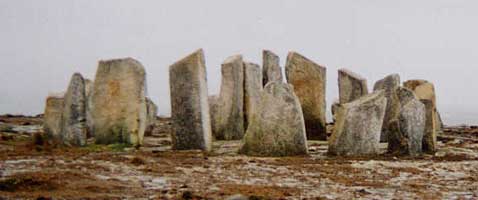 Hundreds of stone circles mark pre-Celtic Ireland and much of Pagan Europe. Stonehenge is the most famous of them. Stonehenge was an astronomical site. The less well-known stone circles of Ireland and elsewhere probably also had astronomical significance. Those stone circles may have been stone age calendars to keep track of time. Each tribe or locale may have had a community calendar with a person assigned to move markers around the circles to count days, weeks, months, and to keep track of seasonal events.
Hundreds of stone circles mark pre-Celtic Ireland and much of Pagan Europe. Stonehenge is the most famous of them. Stonehenge was an astronomical site. The less well-known stone circles of Ireland and elsewhere probably also had astronomical significance. Those stone circles may have been stone age calendars to keep track of time. Each tribe or locale may have had a community calendar with a person assigned to move markers around the circles to count days, weeks, months, and to keep track of seasonal events.
(See the Alphabet I page of this website for more about ancient astronomy.)
ADDENDUM #1
The name Irish is derived from the name of Assur. The name Irish is a form of Assur(Ashur) said backwards. Irish said backwards is Ish-Ur. The vowels are slightly different and the order of sounds is different, but the names Assur and Irish(Ish-Ur) are both derived from the dragon sound, the hiss of the asp and the whirr of hawk's wings. Their name says that the Irish were children of Isis and Heru.
The name Ireland is a form of UrRe-land. The name Eire(ere)(aire) is another UrRe-an name for Ireland. The names Erin(Eireann), Iran and Biblical Aaron are derived from Ur-an, meaning they were sons of Ur the hawk god.
(See the Alphabet
N page on this web site for a discussion regarding the letter N = son.)
Ireland was one of the UrRean nations of the Pagan ancestral empire of the Isis bloodline. Pre-Celtic Irish kings were of the same family of "divine" kings as were the Pharaohs of Egypt and the Ashurs of Mesopotamia. The later Celtic kings were also sons of Isis and Heru before they arrived in Ireland (c. 500 BC).
(See the
Sunwing page on this web site for a description of who were the UrReans.)
ADDENDUM #2 (Copied from the Alphabet S page on this web site.)
The hiss of the asp and the whirr of hawk's wings, hiss + ur and ur + hiss, are natural sounds that have become structural parts of our language and culture. The name of Assur is composed of hiss + ur, the hiss of the asp and the whirr of hawk's wings. The names Osiris, Sirius, Caesar, Czar, Aesir, Cyrus, Syria, Assyria, and many others are, derivatives of the name Assur. The words sire, sir, sure, assure, seer, vi-zier, and ad-vi-sor are also derivatives of the name Assur. Hence all of those names and words (along with many others) are derived from the hiss of the asp and the whirr of hawk's wings.
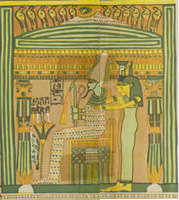
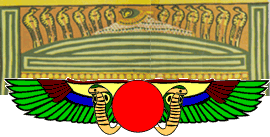
In this version of the Judgment Scene, a hawk and serpent motif soars above Assur seated on his Judgment Throne. The word soar is derived from hiss + ur, the hiss of the asp and the whirr of hawk's wings. The hawk and serpent motif from the Judgment Scene is the source of the winged Uraeus symbol of the Pagan religion. Assur and Isis are the Pagan Adam and Eve. They are the source, from which we all sprang. The word source is derived from hiss + ur, the hiss of the asp and the whirr of hawk's wings. The name Uraeus is derived from ur + hiss, the whirr of hawk's wings and the hiss of the asp. (See the Sun wing page of this web site.)
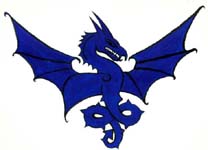
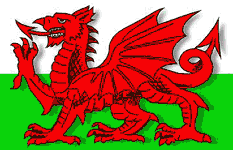

A dragon is a winged reptile. The dragon is an evolved form of the Uraeus sun wing. The Uraeus is a combined form of Heru and Isis, the Hawk God and Serpent Goddess. Isis and Heru together are the dragon of Pagans. Isis and Heru together are the original dragon from which dragon symbolism the world over began.
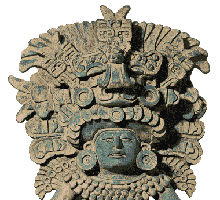 Chinese dragons, Siamese dragons, Welsh dragons, and Mexican dragons all trace their origins to the same source. The winged dragon atop this Zapotec burial urn from Mexico traces the Zapotecs to the same Pagan family origins as the Welsh and the Irish.
Chinese dragons, Siamese dragons, Welsh dragons, and Mexican dragons all trace their origins to the same source. The winged dragon atop this Zapotec burial urn from Mexico traces the Zapotecs to the same Pagan family origins as the Welsh and the Irish.
Although Cymur, the Welsh dragon, has elements of other animals added to it, the Welsh dragon also traces its roots to Isis and Heru. The name Cymur (Sim-ur) is derived from hiss + M (mother) + ur. Cymur (Sim-ur) is the mother dragon of the Cymry (Sim-ree). The Cymry (Sim-ree) are the Celtic people of Wales. Their origins are revealed in their name. The name Cymry (Sim-ree) is a variation of Sim+UrRe. That is Isis Mother plus Ur, the Hawk God plus Re, the Sun God. The Welsh are of the same Pagan family of UrRe Areans as were the Sumerians, Akkadians, and Nile Delta Egyptians discussed on the Sunwing page of this web site.
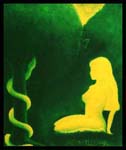
The Genesis of Isis went everywhere. Assur, Isis, and Heru are the ancient dragon ancestors of Egypt, China, England, Mexico, and Wales. Hiss+ur is the dragon sound. HissWhirr, Assur, is the dragon's name. We are all children of that dragon. The "dragon" that St. George slew in England was the Pagan dragon of Isis and Heru. The name Irish is derived from ur + hiss, the whirr of hawk's wings and the hiss of the asp. The "snakes" that St. Patrick drove out of Ireland (UrRe Land) were children of the Serpent Goddess, Eve.
Resurrect Isis. Give the Goddess a chance. Her love can unite this world that fear and greed has bitterly divided.
|
Reader responses are invited. |
Return to Home Page . . . Return to Table of Contents Hub
Links to related topic pages:
Isis in Central America . . . Isis in North America . . . Sunwing . . .
Alphabet Page V . . . Alphabet Page M . . . Alphabet Page W . . .
Alphabet Page I . . . Alphabet Page N